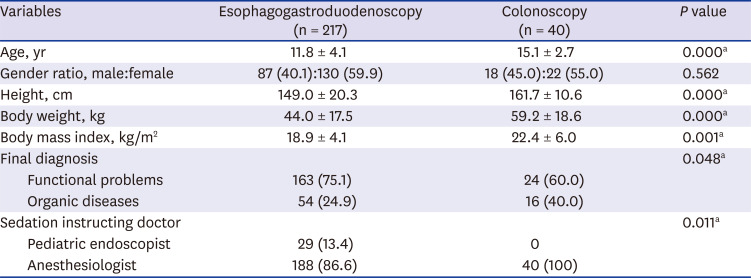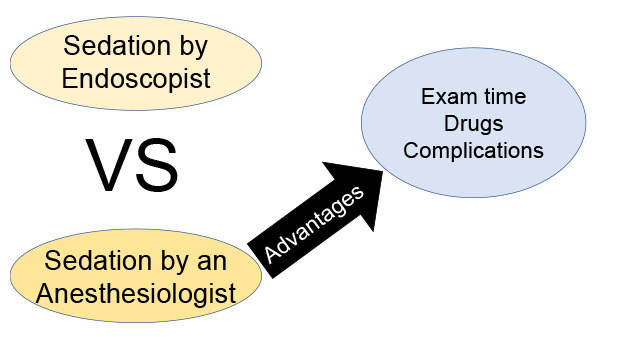1. Thomson M, Tringali A, Dumonceau JM, Tavares M, Tabbers MM, Furlano R, et al. Paediatric gastrointestinal endoscopy: European Society for Paediatric Gastroenterology Hepatology and Nutrition and European Society of Gastrointestinal Endoscopy Guidelines. J Pediatr Gastroenterol Nutr. 2017; 64(1):133–153. PMID:
27622898.

2. Wyllie R, Kay MH. Gastrointestinal endoscopy in infants and children. Pediatr Rev. 1993; 14(9):352–359. PMID:
8247970.

3. Pall H, Lerner D, Khlevner J, Reynolds C, Kurowski J, Troendle D, et al. Developing the pediatric gastrointestinal endoscopy unit: a clinical report by the endoscopy and procedures committee. J Pediatr Gastroenterol Nutr. 2016; 63(2):295–306. PMID:
26974415.

4. Sargin M, Uluer MS, Aydogan E, Hanedan B, Tepe Mİ, Eryılmaz MA, et al. Anxiety levels in patients undergoing sedation for elective upper gastrointestinal endoscopy and colonoscopy. Med Arh. 2016; 70(2):112–115.

5. Isik IA, Iyilikçi L, Ozturk Y, Adiyaman E. sedation practice outside the operating room for pediatric gastrointestinal endoscopy. Indian Pediatr. 2015; 52(11):989–990. PMID:
26615354.

6. Coté CJ, Wilson S. American Academy of Pediatrics. American Academy of Pediatric Dentistry. Guidelines for monitoring and management of pediatric patients before, during, and after sedation for diagnostic and therapeutic procedures. Pediatrics. 2019; 143(6):e20191000. PMID:
31138666.

7. Lightdale JR, Liu QY, Sahn B, Troendle DM, Thomson M, Fishman DS, et al. Pediatric endoscopy and high-risk patients: a clinical report from the NASPGHAN Endoscopy Committee. J Pediatr Gastroenterol Nutr. 2019; 68(4):595–606. PMID:
30664560.

8. Lee MC. Sedation for pediatric endoscopy. Pediatr Gastroenterol Hepatol Nutr. 2014; 17(1):6–12. PMID:
24749082.

9. Chung HK, Lightdale JR. Sedation and monitoring in the pediatric patient during gastrointestinal endoscopy. Gastrointest Endosc Clin N Am. 2016; 26(3):507–525. PMID:
27372774.

10. McGrath B, Chung F. Postoperative recovery and discharge. Anesthesiol Clin North America. 2003; 21(2):367–386. PMID:
12812401.

11. Ead H. From Aldrete to PADSS: reviewing discharge criteria after ambulatory surgery. J Perianesth Nurs. 2006; 21(4):259–267. PMID:
16935737.

12. Khalila A, Shavit I, Shaoul R. Propofol sedation by pediatric gastroenterologists for endoscopic procedures: a retrospective analysis. Front Pediatr. 2019; 7:98. PMID:
30972312.

13. Green SM, Klooster M, Harris T, Lynch EL, Rothrock SG. Ketamine sedation for pediatric gastroenterology procedures. J Pediatr Gastroenterol Nutr. 2001; 32(1):26–33. PMID:
11176320.

14. Fredette ME, Lightdale JR. Endoscopic sedation in pediatric practice. Gastrointest Endosc Clin N Am. 2008; 18(4):739–751. PMID:
18922412.

15. Lightdale JR, Acosta R, Shergill AK, Chandrasekhara V, Chathadi K, Early D, et al. Modifications in endoscopic practice for pediatric patients. Gastrointest Endosc. 2014; 79(5):699–710. PMID:
24593951.

16. van Beek EJ, Leroy PL. Safe and effective procedural sedation for gastrointestinal endoscopy in children. J Pediatr Gastroenterol Nutr. 2012; 54(2):171–185. PMID:
21975965.

17. Yoon SW, Choi GJ, Lee OH, Yoon IJ, Kang H, Baek CW, et al. Comparison of propofol monotherapy and propofol combination therapy for sedation during gastrointestinal endoscopy: a systematic review and meta-analysis. Dig Endosc. 2018; 30(5):580–591. PMID:
29526045.

18. Chidambaran V, Costandi A, D'Mello A. Propofol: a review of its role in pediatric anesthesia and sedation. CNS Drugs. 2015; 29(7):543–563. PMID:
26290263.

19. Kamat PP, McCracken CE, Gillespie SE, Fortenberry JD, Stockwell JA, Cravero JP, et al. Pediatric critical care physician-administered procedural sedation using propofol: a report from the Pediatric Sedation Research Consortium Database. Pediatr Crit Care Med. 2015; 16(1):11–20. PMID:
25340297.
20. Rajasekaran S, Hackbarth RM, Davis AT, Kopec JS, Cloney DL, Fitzgerald RK, et al. The safety of propofol sedation for elective nonintubated esophagogastroduodenoscopy in pediatric patients. Pediatr Crit Care Med. 2014; 15(6):e261–e269. PMID:
24849145.

21. Kamat PP, McCracken CE, Gillespie SE, Fortenberry JD, Stockwell JA, Cravero JP, et al. Pediatric critical care physician-administered procedural sedation using propofol: a report from the Pediatric Sedation Research Consortium Database. Pediatr Crit Care Med. 2015; 16(1):11–20. PMID:
25340297.
22. Narula N, Masood S, Shojaee S, McGuinness B, Sabeti S, Buchan A. Safety of propofol versus nonpropofol-based sedation in children undergoing gastrointestinal endoscopy: a systematic review and meta-analysis. Gastroenterol Res Pract. 2018; 2018:6501215. PMID:
30210535.

23. Kim EH, Lee SK. Endoscopist-directed propofol: pros and cons. Clin Endosc. 2014; 47(2):129–134. PMID:
24765594.

24. Rex DK. Endoscopist-directed propofol. Gastrointest Endosc Clin N Am. 2016; 26(3):485–492. PMID:
27372772.

25. Akbulut UE, Kartal S, Dogan U, Akcali GE, Kalayci S, Kirci H. Propofol with and without midazolam for diagnostic upper gastrointestinal endoscopies in children. Pediatr Gastroenterol Hepatol Nutr. 2019; 22(3):217–224. PMID:
31110954.

26. Amini A, Arhami Dolatabadi A, Kariman H, Hatamabadi H, Memary E, Salimi S, et al. Low-dose fentanyl, propofol, midazolam, ketamine and lidocaine combination vs. regular dose propofol and fentanyl combination for deep sedation induction; a randomized clinical trial. Emerg (Tehran). 2018; 6(1):e57. PMID:
30584573.
27. Loh G, Dalen D. Low-dose ketamine in addition to propofol for procedural sedation and analgesia in the emergency department. Ann Pharmacother. 2007; 41(3):485–492. PMID:
17341533.

28. Phillips W, Anderson A, Rosengreen M, Johnson J, Halpin J. Propofol versus propofol/ketamine for brief painful procedures in the emergency department: clinical and bispectral index scale comparison. J Pain Palliat Care Pharmacother. 2010; 24(4):349–355. PMID:
21133742.

29. Ghojazadeh M, Sanaie S, Paknezhad SP, Faghih SS, Soleimanpour H. Using ketamine and propofol for procedural sedation of adults in the emergency department: a systematic review and meta-analysis. Adv Pharm Bull. 2019; 9(1):5–11. PMID:
31011553.

30. Schmitz A, Weiss M, Kellenberger C, O'Gorman Tuura R, Klaghofer R, Scheer I, et al. Sedation for magnetic resonance imaging using propofol with or without ketamine at induction in pediatrics-A prospective randomized double-blinded study. Paediatr Anaesth. 2018; 28(3):264–274. PMID:
29377404.

31. Sargin M, Uluer MS, Aydogan E, Hanedan B, Tepe Mİ, Eryılmaz MA, et al. Anxiety levels in patients undergoing sedation for elective upper gastrointestinal endoscopy and colonoscopy. Med Arh. 2016; 70(2):112–115.

32. Hayhoe S, Pallett S, Zani J, Trott J. Reduction of postanesthetic pediatric distress: a coordinated approach. J Perianesth Nurs. 2018; 33(3):312–318.e1. PMID:
29784261.

33. Moncel JB, Nardi N, Wodey E, Pouvreau A, Ecoffey C. Evaluation of the pediatric post anesthesia discharge scoring system in an ambulatory surgery unit. Paediatr Anaesth. 2015; 25(6):636–641. PMID:
25581378.

34. Jain A, Gombar S, Ahuja V. Recovery profile after general anaesthesia in paediatric ambulatory surgeries: desflurane versus propofol. Turk J Anaesthesiol Reanim. 2018; 46(1):21–27. PMID:
30140497.

35. Szabó EZ, Luginbuehl I, Bissonnette B. Impact of anesthetic agents on cerebrovascular physiology in children. Paediatr Anaesth. 2009; 19(2):108–118. PMID:
19040505.
36. Karsli C, Luginbuehl I, Farrar M, Bissonnette B. Propofol decreases cerebral blood flow velocity in anesthetized children. Can J Anaesth. 2002; 49(8):830–834. PMID:
12374713.

37. Bacon RC, Razis PA. The effect of propofol sedation in pregnancy on neonatal condition. Anaesthesia. 1994; 49(12):1058–1060. PMID:
7864321.

38. Lanigan C, Sury M, Bingham R, Howard R, Mackersie A. Neurological sequelae in children after prolonged propofol infusion. Anaesthesia. 1992; 47(9):810–811. PMID:
1415983.

39. Chidambaran V, Sadhasivam S, Diepstraten J, Esslinger H, Cox S, Schnell BM, et al. Evaluation of propofol anesthesia in morbidly obese children and adolescents. BMC Anesthesiol. 2013; 13(1):8. PMID:
23602008.

40. Igarashi T, Nagata O, Iwakiri H, Ikeda M, Uezono S, Ozaki M. Two cases of intraoperative awareness during intravenous anesthesia with propofol in morbidly obese patients. Masui. 2002; 51(11):1243–1247. PMID:
12481451.
41. Olutoye OA, Yu X, Govindan K, Tjia IM, East DL, Spearman R, et al. The effect of obesity on the ED(95) of propofol for loss of consciousness in children and adolescents. Anesth Analg. 2012; 115(1):147–153. PMID:
22575569.











 PDF
PDF Citation
Citation Print
Print




 XML Download
XML Download